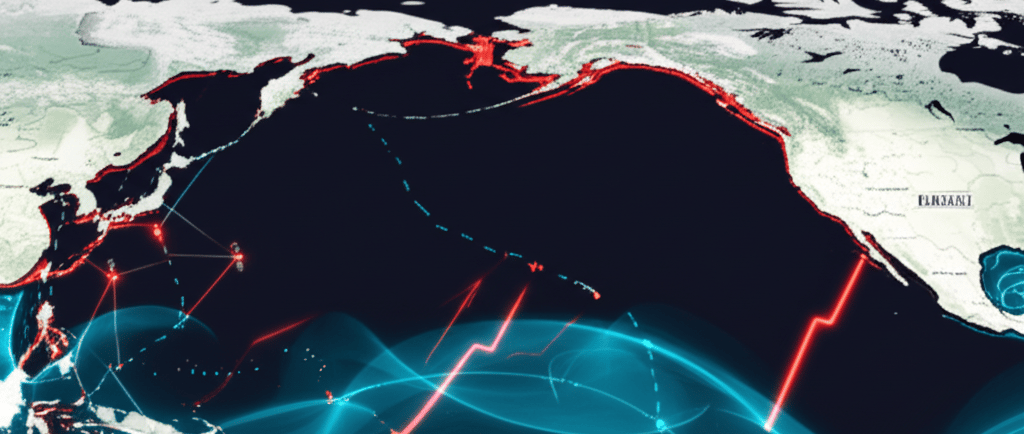When Russia Rumbles, the Pacific Trembles: Unpacking the 8.7 Quake That Rocked Our World (Literally!)
Powerful 8.7‑magnitude earthquake off Russia triggers tsunami alerts across Hawaii, Alaska, and U.S. West Coast. Unpack the quake’s causes, risks & response.
HEALTH NEWS
7/30/20255 min read


Did You Feel That?! A Wake-Up Call from the Pacific Rim
Imagine this: you're in Honolulu, half-awake, the scent of plumeria still clinging to the morning air. Suddenly, a shrill alert pierces the tranquility – a tsunami warning. A jolt to the system, wouldn't you agree? On July 29, 2025, that scenario played out for many as a powerful magnitude 8.7 earthquake struck off Russia's Kamchatka Peninsula. This wasn't just a local tremor; it was a seismic event felt across the Pacific, triggering a cascade of alerts stretching from Russia and Japan to the U.S. West Coast, Alaska, and Hawaii.
But what exactly happened in the remote waters off Kamchatka? What historical echoes reverberate from this geologically volatile region? How do our increasingly sophisticated technologies attempt to anticipate and mitigate the tsunami threat? And perhaps most importantly, what are the inherent limitations and lingering questions that continue to challenge our preparedness? Let's delve into the earth's unrest, the science, the human endeavors, and the ever-present quest for safety in a world prone to seismic surprises.
II. The Big Rumble: What Went Down Off Kamchatka?
The Nitty-Gritty Details:
The epicenter was located off the eastern coast of Russia's Kamchatka Peninsula. The very name, Petropavlovsk-Kamchatsky, whispers of a place both distant and intrinsically linked to the earth's raw power. On Tuesday, July 29, 2025, in the evening hours Eastern Time, a colossal magnitude 8.7 earthquake struck. For context, this was the most significant global seismic event witnessed since 2011. The shallow depth of the quake's origin was a key factor, amplifying its potential to generate a tsunami that could traverse vast oceanic distances.
The Ripple Effect: Tsunami Alerts Go Wild!
The immediate aftermath saw tsunami warnings issued for coastal regions of Russia and Japan. Japan braced for waves potentially reaching up to 1 meter. For Hawaii, the situation escalated to a full-blown tsunami warning, predicting "widespread hazardous waves" with an estimated arrival time of 1:17 AM ET. Alaska, too, found itself under advisories and warnings, particularly the Aleutian Islands, with concerns centering on strong currents and dangerous wave activity. Further south, the U.S. West Coast – California, Oregon, and Washington – were placed on "tsunami watch," a state of heightened vigilance.
A quick primer: A "tsunami warning" means that a dangerous tsunami is imminent or expected, and evacuation is recommended. A "tsunami advisory" indicates that strong currents or waves are expected and could be hazardous. A "tsunami watch" suggests that a tsunami is possible, and it's wise to stay informed.
Early reports thankfully indicated minimal damage in Kamchatka, with only a kindergarten sustaining damage and no immediate reports of injuries. Japan experienced only a slight tremor.
III. Kamchatka: The Pacific's "Ring of Fire" Hotspot
Why Always Here?:
Kamchatka's frequent seismic activity isn't random; it's a consequence of its location along the infamous Pacific "Ring of Fire." This horseshoe-shaped region encircling the Pacific Ocean is where the Earth's tectonic plates engage in a perpetual, grinding dance. It is a zone of subduction where one plate is forced beneath another, leading to frequent earthquakes and volcanic eruptions.
A Tremor-Filled Timeline:
Kamchatka's history is punctuated by powerful earthquakes and devastating tsunamis. It's a region intimately familiar with the earth's capricious nature.
Flashback to History's Monsters:
Consider these historical events:
1737: A colossal earthquake, estimated at a magnitude of 9.0-9.3, unleashed a 60-meter tsunami. The scale of such an event is almost incomprehensible.
1952: The M9.0 Severo-Kurilsk earthquake – Russia's most powerful on record and the fifth strongest globally since 1900. The resulting 15-18 meter waves claimed over 2,300 lives and caused damage as far away as Hawaii.
Weeks before the 8.7 quake, a M7.4 quake near Kamchatka triggered temporary Pacific warnings.
IV. Taming the Waves: How Tsunami Warning Systems Try to Save the Day
From Rumble to Red Alert:
The development of tsunami warning systems represents a crucial chapter in our ongoing effort to mitigate natural disasters. The catastrophic tsunamis of 2004 in Sumatra and 2011 in Tohoku served as stark reminders of the need for improved detection and warning capabilities.
The Tech Toolbox:
The modern tsunami warning system is a complex tapestry woven from various technologies. DART buoys (Deep-ocean Assessment and Reporting of Tsunamis) detect pressure changes indicative of a tsunami. Seismic networks monitor ground motion to identify potential tsunami-generating earthquakes. Tide gauges measure sea levels, while GPS and satellite altimetry track the progression of waves across the ocean.
The objective is ambitious: to issue timely and accurate threat advice within 10-20 minutes of a potentially tsunami-generating earthquake.
Your Role in Preparedness:
Public education, awareness campaigns, and community programs like NOAA's "TsunamiReady" are vital in ensuring that communities are prepared and can respond effectively when a tsunami threatens.
V. Bumps in the Road: The Challenges & Controversies of Tsunami Warnings
The Tricky Balance:
Tsunami warning systems grapple with a fundamental tension: the need for rapid dissemination of information versus the imperative of ensuring accuracy. False alarms can erode public trust and create complacency, making it less likely that people will respond appropriately when a genuine threat emerges.
The "Cry Wolf" Problem:
Historically, a significant percentage of tsunami warnings – some estimates suggest up to 75% in the Pacific – have turned out to be false alarms.
The Cost: False alarms carry tangible financial costs. Consider Hawaii's $30 million false alarm in 1994.
Communication Gaps:
Ensuring that warnings effectively reach at-risk populations is an ongoing challenge. This involves navigating technological hurdles, such as the reliability of sirens and cell phone alerts, as well as addressing linguistic and cultural barriers.
Behind the Scenes Hurdles:
Maintaining the technological infrastructure of tsunami warning systems requires sustained funding. DART buoys are expensive to deploy and maintain. Integrating diverse systems across international borders requires ongoing collaboration and standardization.
The "Silent Threat": Tsunamis triggered by underwater landslides represent a particularly difficult challenge, as they can occur without a major earthquake and are harder to detect quickly.
VI. Peering into the Future: Smarter Waves, Smarter Warnings
Beyond Buoys: Next-Gen Tech on the Horizon:
"SMART Cables": This involves repurposing existing undersea internet cables into massive sensor networks, providing real-time seismic and tsunami data from the ocean depths.
Acoustic Detection: Hydrophones (underwater microphones) can detect the sound waves generated by earthquakes, which travel faster than tsunamis, providing valuable early warning time. "Global Real-time Early Assessment of Tsunamis (GREAT)" systems are being developed to harness this technology.
The AI Revolution: Artificial Intelligence and Machine Learning are increasingly being used to analyze vast datasets, automate tsunami detection, predict wave behavior, and reduce the incidence of false alarms.
Advanced Seismic Monitoring: New fiber-optic sensing (DAS) technologies are creating ultra-dense seismic networks, while magnetometers (both on land and in satellites) are being explored for their potential to detect subtle changes in the Earth's magnetic field associated with seismic activity.
Global Harmony:
International cooperation is essential for effective tsunami warning. Sharing data, standardizing warning products, and coordinating responses across borders are crucial for ensuring the safety of coastal communities worldwide.
The Realistic Outlook:
While deterministic earthquake prediction remains elusive, forecasting and early warning systems are continually evolving to minimize the impact of tsunamis.
VII. Your Safety Toolkit: What to Do When the Earth Trembles
Know the Natural Warnings:
This is your first line of defense. If you're near the coast and experience a strong, prolonged earthquake, or if you observe unusual ocean behavior (a sudden roar or a rapid withdrawal of water from the shoreline), evacuate immediately to higher ground. Do not wait for an official alert.
Have a Plan:
Identify your tsunami hazard zone, know your evacuation routes, and designate safe zones (ideally at least 100 feet above sea level or one mile inland).
Stay Informed:
Pay attention to official emergency alerts issued by local authorities.
VIII. Conclusion: Staying Prepared in a Shaky World
The magnitude 8.7 earthquake off Kamchatka served as a stark reminder of the power of our planet and the interconnectedness of our coastal regions. We live on a dynamic Earth, and while we cannot prevent earthquakes or tsunamis, we can continue to refine our understanding, improve our warning systems, and enhance our preparedness. Being aware, informed, and prepared is your best defense against the next big wave. Stay safe.
Connect
Join us for wellness insights and natural remedies.
Explore
Discover
673-456-7890
© 2025. All rights reserved.
